Low-sodium chicken stew is a nourishing dish that packs a flavorful punch without the excess sodium. Start with skinless, boneless chicken and sauté colorful veggies like carrots, celery, and bell peppers in olive oil for sweetness. Don't forget to season with garlic, thyme, and paprika for depth. Use low-sodium chicken broth and a splash of lemon juice to enhance the flavor even more. Serve it warm in bowls, garnished with fresh herbs and paired with whole-grain bread. You'll find it not only boosts your energy but supports overall well-being, and there's so much more to explore about this delightful dish.
Key Takeaways
- Use skinless, boneless chicken and colorful, seasonal vegetables like carrots and bell peppers for a nutritious base.
- Sauté vegetables in olive oil, adding garlic and onions for enhanced flavor without excess sodium.
- Marinate chicken with olive oil and herbs like thyme and rosemary to boost taste while keeping sodium low.
- Opt for low-sodium chicken broth and add fresh herbs or a splash of lemon juice for additional flavor.
- Serve the stew with whole-grain bread or a light salad for a balanced, satisfying meal.
Benefits of Low-Sodium Diet
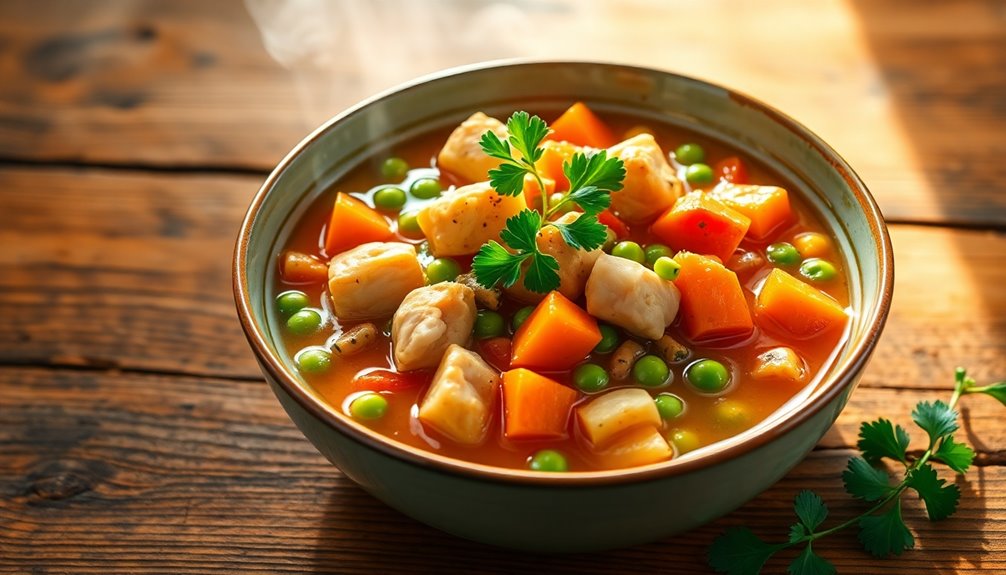
A low-sodium diet can transform your health in remarkable ways. When you make the conscious choice to reduce sodium intake, you're not just cutting out salt; you're opening the door to a world of health benefits. Imagine feeling more energized, with reduced bloating and improved blood pressure. You might even notice a clearer mind and better sleep. It's about reclaiming your well-being, and you deserve that.
One of the biggest misconceptions about a low-sodium diet is that it means sacrificing flavor. But that's where you'll be pleasantly surprised! There are many flavorful alternatives to salt that can elevate your meals. Fresh herbs, spices, and citrus zest can bring out the natural taste of your ingredients, making each bite a delightful experience.
Think of using garlic, rosemary, or even a splash of vinegar to add depth to your dishes. You'll find that with a little creativity, your meals can still be bursting with flavor without the need for excessive salt.
Essential Ingredients for Stew
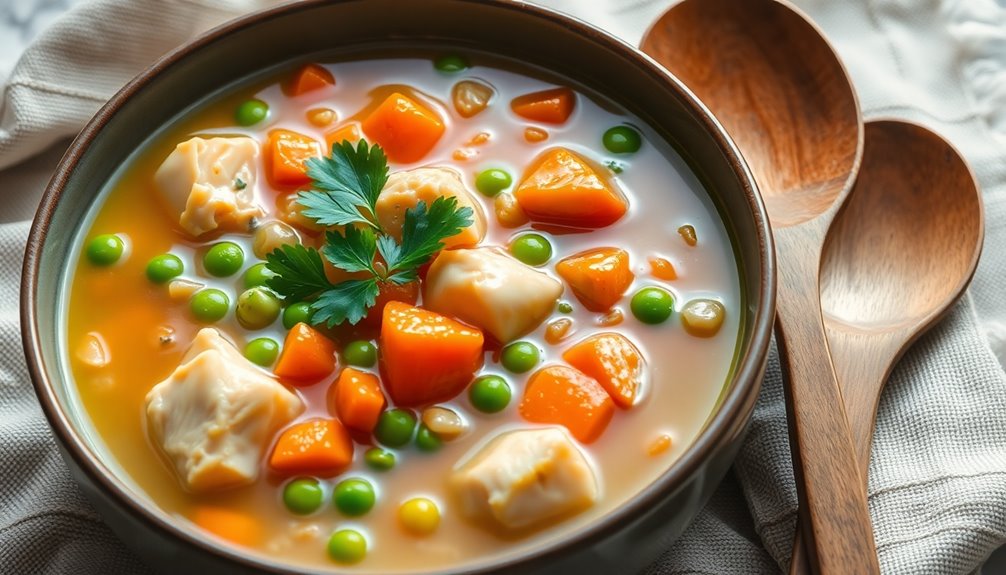
Crafting a delicious low-sodium chicken stew starts with selecting the right ingredients. Begin with fresh, high-quality chicken, preferably skinless and boneless, to keep the dish light and healthy.
Next, gather an array of colorful vegetables—think carrots, celery, and bell peppers. These not only add texture but also infuse your stew with vibrant flavors.
When it comes to cooking techniques, sautéing your vegetables in a splash of olive oil before adding the chicken can enhance their natural sweetness. This method brings out the best in your ingredients, creating a base that's both aromatic and inviting.
Don't forget to add garlic and onions; they're essential for building depth in your stew.
Now, let's talk about seasoning options. Instead of reaching for salt, consider using herbs like thyme, rosemary, and bay leaves. Fresh herbs can elevate your stew and bring a sense of warmth and belonging to your meal.
You can also experiment with spices like paprika or black pepper to add a little kick without the sodium.
Preparing the Chicken
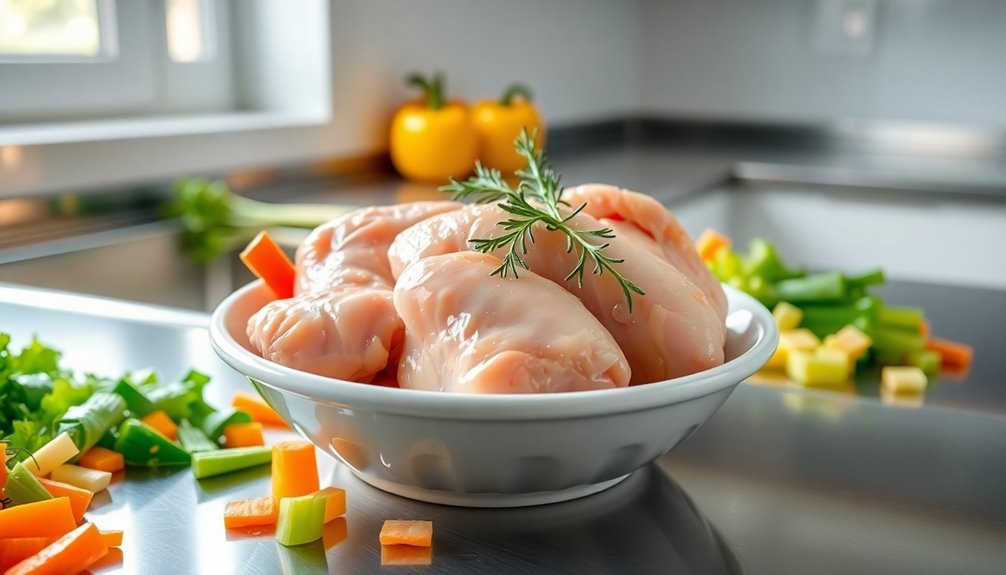
When you're preparing the chicken for your low-sodium stew, start by trimming away any excess fat and cutting the meat into bite-sized pieces. This will help the chicken cook evenly and absorb all those delicious flavors you're about to add.
Consider using a brining technique to enhance the chicken's moisture and tenderness. A simple brine made of water, apple cider vinegar, and herbs can elevate the flavor without adding sodium. After brining, rinse the chicken and pat it dry.
Next, think about your seasoning options. You can create a delightful marinade using olive oil, lemon juice, garlic, and your favorite herbs such as thyme or rosemary. Letting the chicken marinate for at least 30 minutes will infuse it with flavor, making each bite a delight.
Here's a quick reference table for your chicken preparation:
| Brining Technique | Seasoning Options | Marinade Ideas |
|---|---|---|
| Water & Vinegar | Herbs (Thyme, Rosemary) | Olive Oil & Lemon Juice |
| Salt-Free Option | Garlic & Pepper | Soy Sauce & Ginger (low-sodium) |
| Add Sugar for Sweetness | Paprika & Cumin | Honey & Mustard |
| Chill for 1-2 hours | Chili Flakes | Yogurt & Spices |
| Rinse Before Cooking | Fresh Herbs | Balsamic Vinegar |
Choosing the Right Vegetables
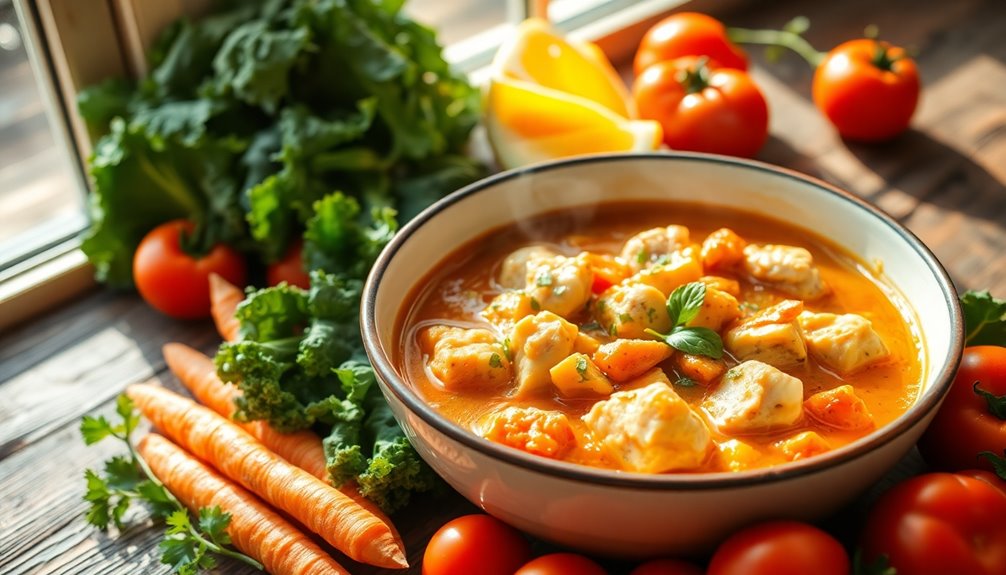
As you immerse yourself in creating your low-sodium chicken stew, selecting the right vegetables is key to enhancing both flavor and nutrition. Think about the vibrant, colorful veggies that not only provide essential nutrients but also elevate the presentation of your dish. A mix of bell peppers, carrots, and zucchini can transform your stew into a feast for the eyes and the palate.
When it comes to vegetable selection, aim for variety. Each vegetable brings its unique set of vitamins and minerals to the table. For instance, carrots are rich in beta-carotene, while bell peppers offer a hearty dose of vitamin C. By incorporating a rainbow of colors, you're not just making your stew look appealing; you're also packing it with a wealth of nutrients that promote overall health.
Don't shy away from seasonal vegetables either. Fresh, in-season produce tends to be at its peak flavor and nutrition, ensuring your stew is both delicious and wholesome. Consider adding sweet potatoes for a creamy texture or green beans for a satisfying crunch.
As you chop and toss these colorful veggies into your pot, you'll feel a sense of connection to the food you're creating. Every ingredient you choose plays a part in crafting a warm, nourishing meal, perfect for sharing with family and friends. Enjoy the process, and let your vegetable selection shine in your low-sodium chicken stew!
Flavorful Herbs and Spices
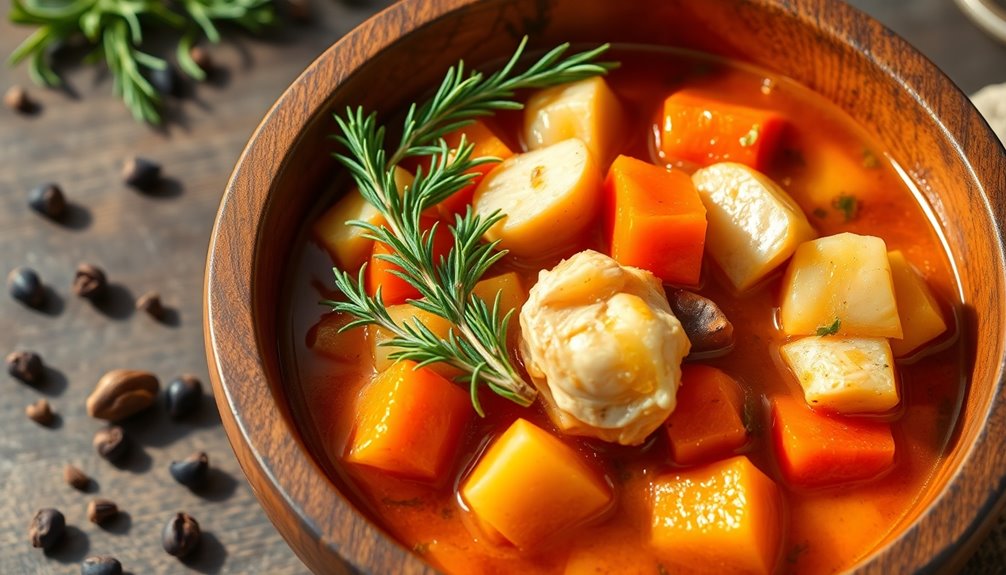
Herbs and spices can truly elevate your low-sodium chicken stew, bringing a burst of flavor that transforms simple ingredients into a delicious masterpiece. By embracing a variety of seasoning options, you can create a dish that resonates with your taste preferences while maintaining a healthy balance.
Start with aromatic herbs like thyme, rosemary, and parsley. These fresh notes add depth and complexity, enhancing the natural flavors of your chicken and vegetables. If you prefer a bit of heat, consider adding crushed red pepper flakes or a pinch of cayenne. They'll provide a delightful kick without the need for salt.
Don't overlook the power of spices! Paprika adds a smoky richness, while cumin introduces an earthy warmth. For a zesty flair, lemon zest or a splash of vinegar can brighten the entire dish, creating a perfect flavor balance that makes each bite exciting.
Experimenting with garlic and onion powder can also enhance taste without increasing sodium levels. These sodium alternatives can help you achieve that savory depth often associated with traditional stews.
Lastly, remember to taste as you go. Adjusting herbs and spices based on your palate will guarantee the stew feels like it's tailor-made for you. With these flavorful additions, your low-sodium chicken stew won't only nourish your body but also bring a sense of community and comfort to your dining experience. Enjoy crafting a dish that everyone will love!
Cooking Instructions
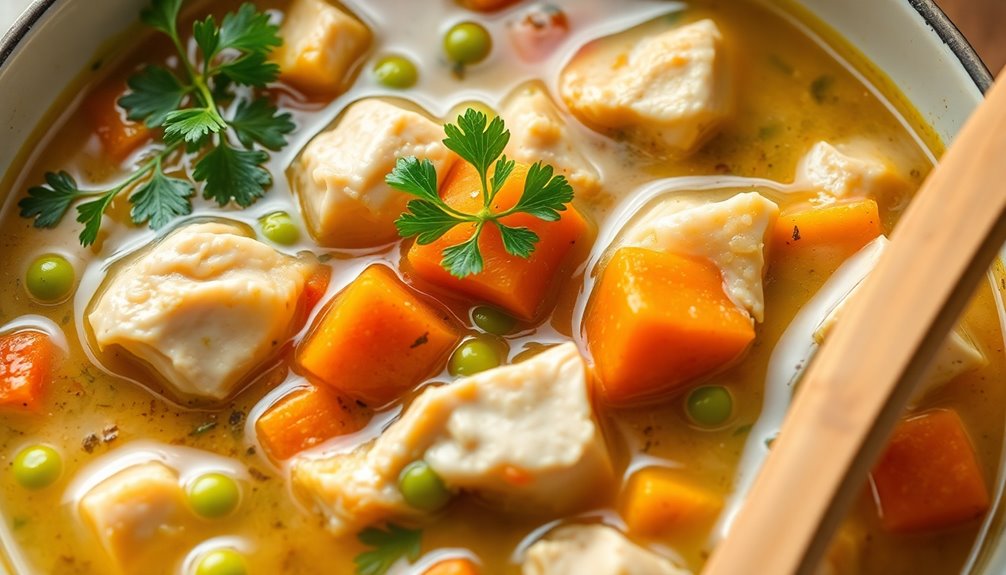
How do you bring all those wonderful flavors together in your low-sodium chicken stew? It's simpler than you might think! By following these steps, you'll create a hearty dish that caters to your taste preferences while considering any dietary restrictions.
- Start by sautéing your chopped onions, garlic, and carrots in a bit of olive oil. This step enhances the flavors, so don't skip it!
- Add your chicken pieces, letting them brown slightly before adding in low-sodium broth, potatoes, and your choice of vegetables like green beans or bell peppers.
- Season with your flavorful herbs and spices, like thyme, rosemary, and a sprinkle of black pepper.
Now, if you want to save time, consider using a pressure cooker or slow cooker. These time-saving techniques allow the flavors to meld beautifully while you're busy with other tasks. You can also make ingredient substitutions based on what you have on hand. For instance, if you're out of chicken, turkey or even chickpeas work great!
As the stew simmers, the aroma will fill your kitchen, inviting family and friends to gather around. This isn't just a meal; it's a comforting experience that brings everyone together. So, embrace your creativity and let your low-sodium chicken stew reflect your unique tastes while accommodating any dietary needs. You're not just cooking; you're creating a space for connection. Enjoy the process!
Serving and Storage Tips
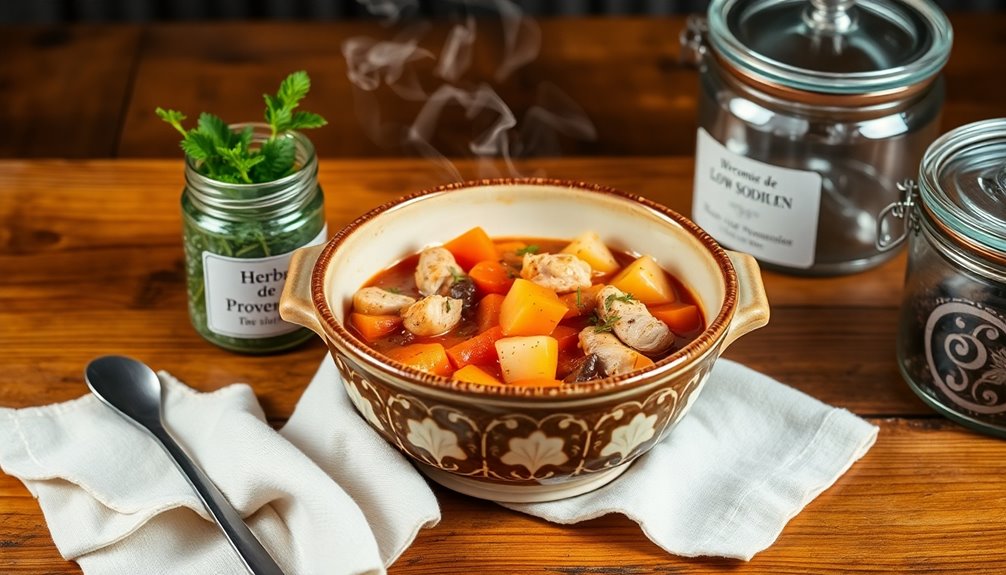
Once your low-sodium chicken stew has simmered to perfection, it's time to think about how you'll serve and store this delightful dish. To truly impress your family or friends, ladle the stew into warm bowls, garnishing each with a sprinkle of fresh herbs like parsley or thyme. Not only does this add a pop of color, but it also enhances the stew's aroma and flavor. If you want to heighten the experience, consider pairing it with a slice of whole-grain bread or a light salad on the side.
When it comes to storage, let your stew cool down before transferring it to airtight containers. It's best to refrigerate leftovers within two hours to guarantee freshness. This stew can last in the fridge for up to three days, although you may find it's too tasty to last that long!
For longer storage, freeze portions in freezer-safe bags, removing as much air as possible. When you're ready to enjoy it again, simply thaw in the refrigerator overnight and reheat gently on the stove.
Frequently Asked Questions
Can I Use Frozen Chicken for This Stew Recipe?
Yes, you can definitely use frozen chicken for your stew! Just make sure to thaw it first to guarantee even cooking. Fresh ingredients, like vegetables and herbs, will enhance your stew's flavor options, making it rich and delicious.
Using frozen chicken can be a great time-saver, allowing you to enjoy a hearty meal without much hassle. Embrace this flexibility, and your stew will still turn out tasty and satisfying!
What Can I Substitute for Chicken if I'm Vegetarian?
If you're looking to swap out chicken for a vegetarian option, think of your plate as a blank canvas waiting for vibrant colors.
Tofu makes a fantastic alternative, soaking up flavors while adding a creamy texture. Alternatively, seitan offers a hearty, chewy experience that mimics meat beautifully.
Both options not only satisfy your cravings but also invite the warmth of togetherness in every bite. You'll feel right at home with these delicious substitutes!
How Long Does Leftover Chicken Stew Last in the Fridge?
Leftover chicken stew typically lasts about three to four days in the fridge. When storing leftovers, make sure you place them in an airtight container to maintain freshness. If you're planning to reheat it, check that it reaches an internal temperature of 165°F for food safety. Stirring occasionally while reheating helps it warm evenly. Enjoy your delicious stew, knowing you're making the most of your meal!
Can I Add Beans for Extra Protein in the Stew?
Adding beans to your stew is like giving it a warm hug of nutrition! You can choose from a variety of bean varieties, like black beans or chickpeas, to boost protein content. Just remember to adjust your cooking techniques; if you're using canned beans, add them towards the end to keep them intact.
For dried beans, soak and cook them separately first. This way, you'll create a hearty dish everyone will love!
Is It Safe to Reheat Chicken Stew Multiple Times?
It's important to think about food safety when reheating chicken stew. While you can reheat it multiple times, try to limit it to two to maintain its flavor enhancement and quality.
Each time you cool and reheat, you risk bacteria growth, which can spoil your meal. Always make sure it's heated thoroughly, reaching a safe temperature.
Conclusion
As you savor each spoonful of your low-sodium chicken stew, let the warm, hearty aroma wrap around you like a cozy blanket on a chilly evening. This nourishing dish not only delights your taste buds but also supports your health with every bite. By choosing fresh ingredients and vibrant herbs, you've created a symphony of flavors that dances on your palate. Enjoy your culinary creation, knowing you've made a delicious choice for both body and soul.



